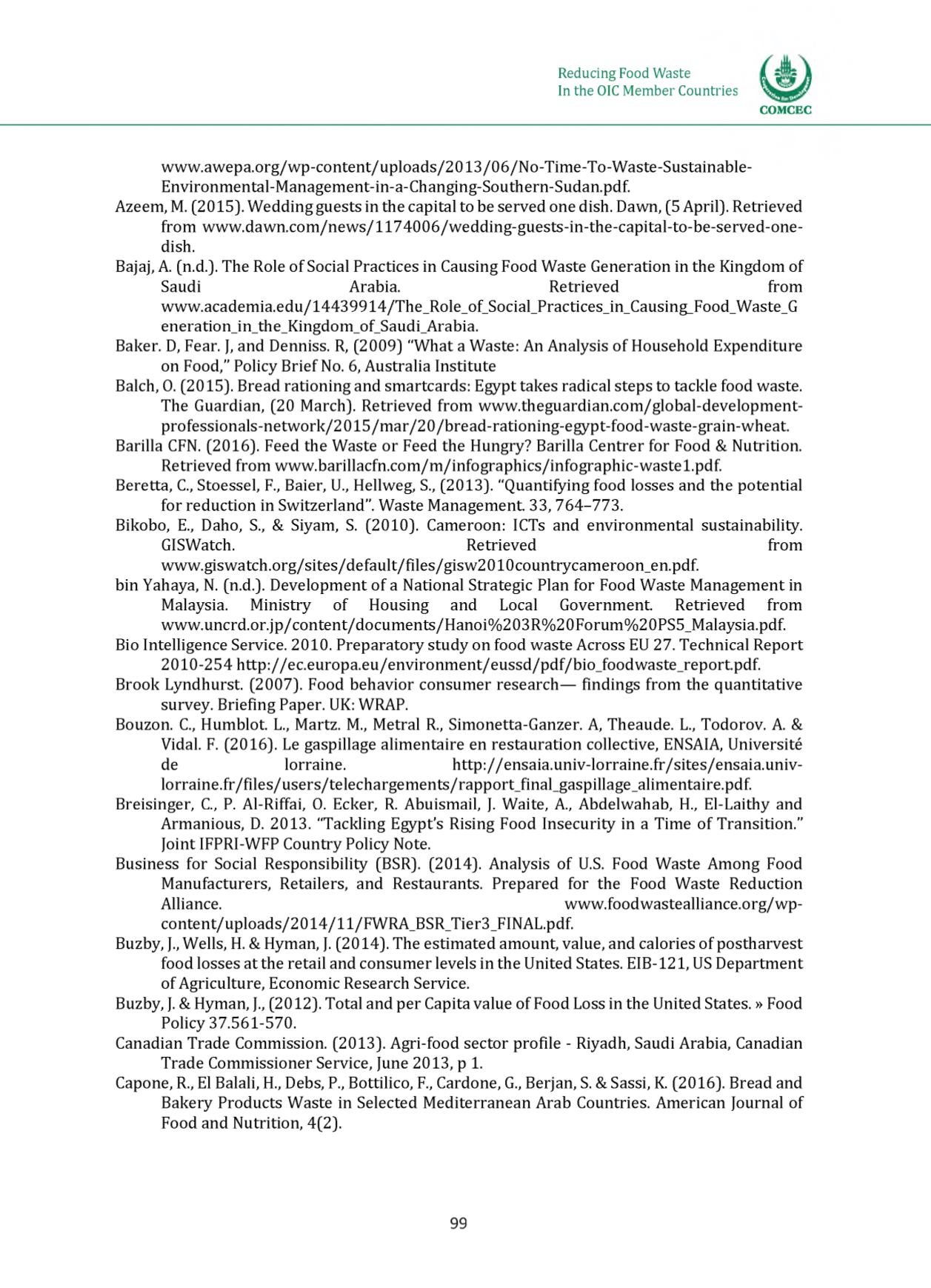

COMCEC
Reducing Food Waste
In the OIC Member Countries
www.awepa.org/wp-content/uploads/2013/06/No-Time-To-Waste-Sustainable-Environmental-Management-in-a-Changing-Southern-Sudan.pdf.
Azeem, M. (2015). W edd ing guests in the capital to be served one dish. Dawn, (5 April). Retrieved
from
www.dawn.com/news/1174006/wedding-guests-in-the-capital-to-be-served-one-dish.
Bajaj, A. (n.d.). The Role o f Social Practices in Causing Food Waste Generation in the K ingdom of
Saudi
Arabia.
Retrieved
from
www.academia.edu/14439914/The_Role_of_Social_Practices_in_Causing_Food_Waste_Generation_in_the_Kingdom_of_Saudi_Arabia.
Baker. D, Fear. J, and Denniss. R, (2009) “W h a t a Waste: An Analysis o f Household Expenditure
on Food,” Policy Brief No. 6, Australia Institute
Balch, O. (2015). Bread ra tioning and smartcards: Egypt takes radical steps to tackle food waste.
The Guardian, (20 March). Retrieved from
www .theguardian.com /global-development-professionals-network/2015/mar/20/bread-rationing-egypt-food-waste-grain-wheat.
Barilla CFN. (2016). Feed the Waste or Feed the Hungry? Barilla Centrer for Food & Nutrition.
Retrieved from
www .barillacfn.com /ni/infographics/infographic-waste1.pdf.
Beretta, C., Stoessel, F., Baier, U., Hellweg, S., (2013). “Quantifying food losses and the potential
for reduction in Sw itzerland”. Waste Management. 33, 764-773.
Bikobo, E., Daho, S., & Siyam, S. (2010). Cameroon: ICTs and environmental sustainability.
GISWatch.
Retrieved
from
www .giswatch.org/sites/default/files/gisw2010countrycameroon_en.pdf.
b in Yahaya, N. (n.d.). Development o f a National Strategic Plan for Food Waste M anagem ent in
Malaysia. M inistry of Housing and Local Government. Retrieved from
www .uncrd .o r.jp /content/docum ents/H ano i% 203R% 20Fo rum% 20PS5_M alaysia.pd f.Bio Intelligence Service. 2010. Preparatory study on food waste Across EU 27. Technical Report
2010-254
h ttp ://ec.europa.eu/environm ent/eussd /pd f/b io_foodw aste_repo rt.pd f.Brook Lyndhurst. (2007). Food behavior consumer research— findings from the quantitative
survey. Briefing Paper. UK: WRAP.
Bouzon. C., Humblot. L., Martz. M., Metral R., Simonetta-Ganzer. A, Theaude. L., Todorov. A. &
Vidal. F. (2016). Le gaspillage alimentaire en restauration collective, ENSAIA, Université
de
lorraine.
http://ensaia.univ-lorraine.fr/sites/ensaia.univ- lorraine.fr/files/users/telechargements/rapport_final_gaspillage_alimentaire.pdf.Breisinger, C., P. Al-Riffai, O. Ecker, R. Abuismail, J. Waite, A., Abdelwahab, H., El-Laithy and
A rmanious, D. 2013. “Tackling Egypt's R ising Food Insecurity in a Time o f Transition.”
Joint IFPRI-WFP Country Policy Note.
Business for Social Responsibility (BSR). (2014). Analysis of U.S. Food Waste Am ong Food
Manufacturers, Retailers, and Restaurants. Prepared for the Food Waste Reduction
Alliance.
www .foodwastealliance.org/wp-content/uploads/2014/11/FWRA_BSR_T ier3_FINAL.pdf.
Buzby, J., Wells, H. & Hyman, J. (2014). The estimated amount, value, and calories o f postharvest
food losses at the retail and consumer levels in the United States. EIB-121, US D epartment
of Agriculture, Econom ic Research Service.
Buzby, J. & Hyman, J., (2012). Total and per Capita value of Food Loss in the United States. » Food
Policy 37.561-570.
Canadian Trade Commission. (2013). Agri-food sector profile -Riyadh, Saudi Arabia, Canadian
Trade Comm issioner Service, June 2013, p 1.
Capone, R., El Balali, H., Debs, P., Bottilico, F., Cardone, G., Berjan, S. & Sassi, K. (2016). Bread and
Bakery Products Waste in Selected Mediterranean Arab Countries. American Journal of
Food and Nutrition, 4(2).
99
















